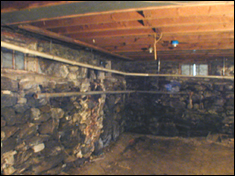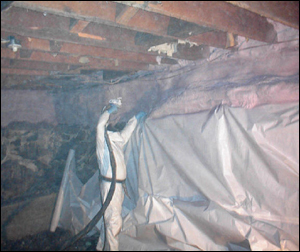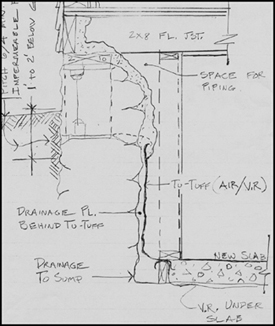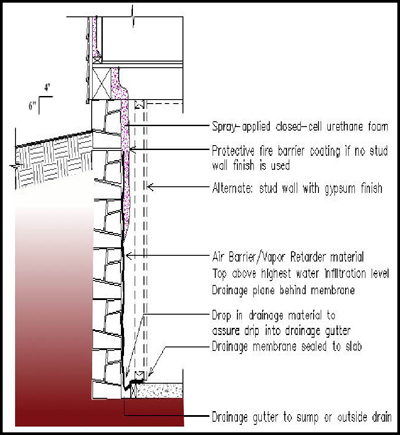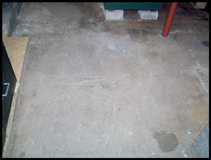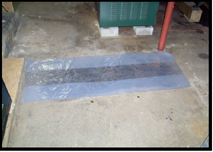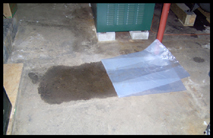The BES/FOAM-TECH AVID System (Air/Vapor/Insulation/Drainage)
Click here for PDF version
The AVID System was developed by Building Envelope Services, Inc. to address the need for installing a complete thermal envelope in basements and crawl spaces with unreinforced stone foundations that may be at risk of structural damage from frost if retrofitted with insulation. It also addresses the need to reduce materials costs for irregular un-pointed (large open spaces) stonework. This system is designed to provide the following:
- Excellent insulation at the sill and top of the foundation wall where it is exposed to the outside temperature extremes,
- Continuous air and vapor barriers,
- A drainage path to manage water that typically migrates through this type of construction, at least on a seasonal basis, which is isolated from the conditioned space.
|
|
|
|
BEFORE: Classic dry-laid stone foundation with signs of frost damage.
|
AFTER: Completed AVID installation
|
|
While this system does not maximize the potential for thermal performance, warmer below-grade temperatures and the overriding need to protect the structure make this approach the best possible compromise. Testing at a 90-unit multifamily complex showed that insulating to a shallow depth, while providing a complete air barrier, still yields superior performance.
This test demonstrates that the humidity of the air inside the crawlspace of the modified unit is very close to that of the living space upstairs. This reduces the likelihood of condensation and related mold, mildew, and insect infestations.
This test demonstrates that the inside temperature of the air in the crawlspace of the modified unit is very close to that of the living space upstairs. This reduces the likelihood of condensation and reduces the likelihood of pipe freeze-ups, frost damage to the structure, and comfort issues in the rest of the unit. Even though these crawl spaces were not actively conditioned, they were able to maintain “indoor” conditions.
This system includes spray-applied polyurethane foam (SPF) insulation from the bottom of the first floor sheathing to a level below grade that provides optimal insulation value against heat loss due to outdoor temperatures, usually about one or two feet. Limiting the insulation depth allows some heat to penetrate to the soils outside the lower foundation.
|
|
|
The top of the wall is insulated; then, the A/V barrier is suspended from the SPF just above the high-water level to complete the envelope and provide a drainage outlet for seasonal water infiltration.
|
|
|
Leaving the bottom of the foundation uninsulated and exposed to warm interior temperatures reduces the risk of frost pressure caused by freezing of the water present in the soils immediately outside of the lower portion of the foundation wall. The SPF controls air leakage and vapor diffusion at the top of the foundation. In order to complete the envelope, the air and vapor control supplied by the SPF at the top of the wall is then extended down to the bottom of the wall using an airtight vapor retarder membrane. This material also provides a “drainage plane” or water flow path outside of it down to the bottom of the foundation wall.
|
|
Sketch of AVID System in section
Showing the configuration at, and beyond, a bulkhead window location.
|
|
|
|
|
Diagram showing how winter snow accumulations that creates ponding and directs water into the basement even though the finished grade is pitched away.
|
|
|
The top of this drainage plane membrane is anchored into position by the SPF at a level determined to be above the highest elevation of seasonal and ground water ingress, thus guaranteeing an outlet for any hydraulic pressure. Ideally, there is a gutter or other means to conduct the water to a sump or drain to the outdoors along the bottom of the wall or under the floor membrane. The bottom of the membrane connects to the vapor retarder incorporated into the floor of the basement or crawlspace.
|
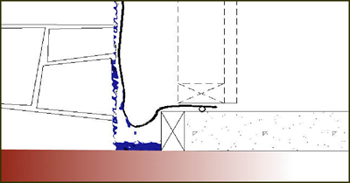
|
|
Detail showing water path directed in gutter to sump or outside drain
|
|
|
|
|
Diagram of the AVID System
|
This forms a continuous vapor retarder, preventing water from evaporating into the indoor space, and completes the air barrier system.
The membrane on the lower portion of the wall has no appreciable R-value and could allow moisture entering from the ground side of the membrane to condense on the outside of this relatively cool surface; however, mold growth in this location poses no risk to the indoor environment as the membrane also forms a barrier which isolates the water and potential mold from the conditioned space.
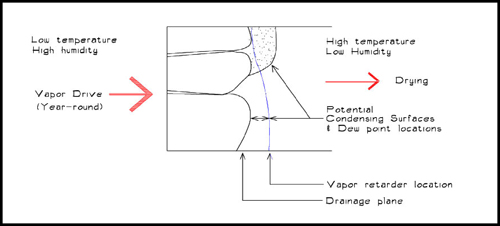
Condensation on the conditioned or inside of the cooler membrane is limited to minimal amounts as the moisture content of the air in the conditioned space is small. Because the AVID system creates conditions similar to those inside a normal above-grade living space, the limited amount of moisture and food content on the inside surface of the membrane is unlikely to support mold growth or rot. The AVID system has been acknowledged by Dr. Nathan Yost of Building Science Corp. as a viable system for addressing air leakage, vapor control, insulation, and drainage while reducing the risk of mold development and frost heave action in foundations with poorly drained soils and/or ground water infiltration.
Finally, the air barrier is tested to confirm continuity. Air leakage quality assurance testing guarantees that the air barrier is complete. This not only provides protection against energy loss, it reduces the likelihood of attracting vermin and indoor air quality from below-grade soil gasses and mold/mildew. Quality assurance testing is low cost, non-destructive, and prevents localized failures and callbacks.
In summary, the AVID system offers a practical solution to improving energy performance without risking frost damage. It has been proven in hundreds of applications including commercial, historic landmark buildings, and many residences. It protects against frozen pipes, vermin, and moisture-related indoor air quality and rot problems.
Additional Notes:
- The drainage system can be designed to also allow for the creation of a sub-slab, low-pressure zone for soil gas (radon, etc.) remediation. Radon testing is recommended after air sealing the foundation and sills.
- Basements and crawl spaces typically should not be ventilated, but this is especially problematic when the outside humidity is higher than the inside.
- Indoor air quality problems may occur if the vapor retarder is not extended down to and across the floor of the space. It is possible to determine if the slab (or similarly, a foundation wall) is a source of moisture with a simple do-it-yourself test.
|
|
|
|
1. Dry slab surface
|
2. Lay a bag on the floor overnight
|
|
|
|
|
3. Remove the bag and see if the slab is wet. This indicates that the water vapor is migrating into the interior space from the ground
|
|
4. The AVID System does not eliminate moisture in basements and crawl spaces with internal moisture sources. For example, dryers should be vented outside and washing machines should be plumbed directly to a drain, not run across the floor to an open floor drain.
Related Information






